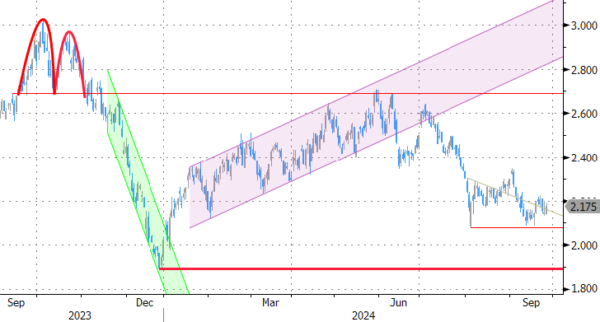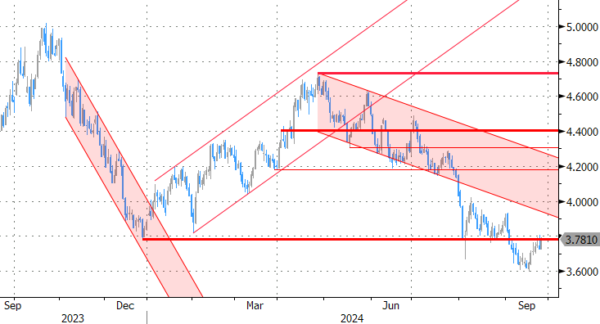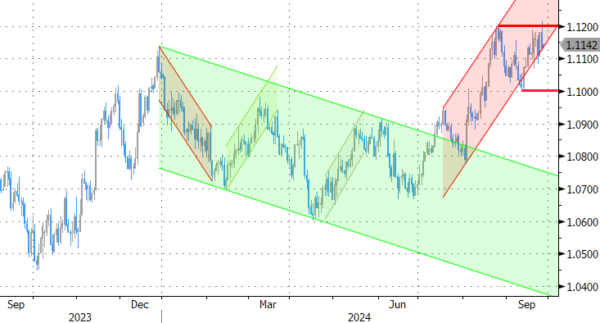Markets
Core bond yields grinded higher yesterday in a news-poor trading session. With the move both US and German yields recouped most of Tuesday’s intraday losses. Net daily changes varied between +2 bps (2-yr) and +5.6 bps (10-yr, 30-yr) in the US and +1.3 bps (30-yr) and +3 bps (5-yr) in Germany. China’s equity boost to the broader equity markets fizzled. The EuroStoxx50 shed about 0.5%, major indices in the US were flat to down 0.7% (DJI). Currency markets were the playground of technical traders. The dollar started weak with the trade-weighted index testing the September lows around 100.2 and EUR/USD attacking the 1.1202 resistance level. But the greenback prevented a break lower and some return action kicked in instead. DXY eventually closed just south of 101 and EUR/USD slid back to 1.1133. JPY weakness helped USD/JPY to close at the highest level in three weeks (144.75).
It’s as if the Chinese were reading along. Some quotes coming from the Politburo during its monthly huddle jolted a dull Asian session in its final trading hours. Chinese authorities promise to implement “forceful” interest rate cuts and said they’ll ensure the necessary fiscal spending. The latter is seen as a critical complementary element to the string of monetary measures announced this Monday aimed to jumpstart the economy. The growing sense of urgency is underscored by the fact that the Politburo discussed the economic situation at the September meeting, whereas this is usually done only in April, July and December. The Chinese CSI300 stock index promptly extended gains to 3%. USD/CNY (7.018) holds on to previous gains. We expect to see some positive fall-out on European markets. Bourse futures suggested a solid green open. For most of the day, though, it’ll be waiting on a speech by Fed chair Powell with second tier US data (jobless claims, durables) offering some minor distraction in the run-up. Powell appears at the annual US Treasury Market Conference and is scheduled to speak along with another heavyweight, NY Fed’s Williams. Powell’s remarks are pre-recorded and there’s no Q&A but any reference to monetary policy may still affect trigger-happy (money) markets looking to add to easing bets. A 50 bps November cut is priced in for 60%. (Front-end) US yields and the dollar remain vulnerable in the current circumstances.
News & Views
The Czech National Bank (CNB) yesterday as expected further reduced its policy ate by 25 bps to 4.25%. The decision was approved by 6 members. One MPC member voted for a 50 bps step. In its communication, the board left the door open to (gradual) further easing. This process is supported by slower growth and slow wage rises, a stronger koruna and above all by increased easing expectations by the major central banks. Still, CNB communication maintained some leaning against the wind elements and stresses that it is necessary to persist with tight monetary policy. It will carefully consider any further rate cuts as risks to inflation still might still resurface. In this respect, August inflation slightly surprised to the upside (2.2%), partly due to higher food prices but also due to services inflation. Ongoing high inflation expectations also are a source of caution. KBC expects the CNB to continue a path of gradual easing, reducing the policy rate 25 bps at each of the next meetings till (including) February 2025. The krona yesterday eased slightly to EUR/CZK 25.16, but this was mainly due to broader market sentiment.
In its semi-annual financial stability report, the reserve Bank of Australia (RBA) assessed that the pressures from high inflation and restrictive monetary policy continue to be felt across the economy, but the share of borrowers experiencing severe financial stress remains small. Business insolvencies have increased sharply over the past couple of years following the removal of pandemic-era support, though they are only slightly above pre-pandemic levels as a share of all businesses. The RBA expects rates will be cut in the period ahead, but for now maintains a wait-and-see approach on the start of its easing cycle. (Too fast) easing is seen as a risk: ‘’Domestic vulnerabilities could increase if households respond to any easing in financial conditions by taking on excessive debt.” Aside from domestic factors, the RBA mainly sees external/risk challenges to financial stability, including vulnerabilities from complexity and interconnectedness in a digitalised world, imbalances in China’s financial sector and disorderly adjustments in global asset prices that can spill over to Australia’s financial system.
Graphs
GE 10y yield
The ECB cut policy rates by 25 bps in June and in September. Stubborn inflation (core, services) make follow-up moves less evident. We expect the central bank to stick with the quarterly reduction pace. Disappointing US and unconvincing-to-outright-weak EMU activity data dragged the long end of the curve down. The move accelerated during the early August market meltdown.
US 10y yield
The Fed kicked off its easing cycle with a 50 bps move. It is headed towards a neutral stance now that inflation and employment risks are in balance. Conservative SEP unemployment forecasts risk being caught up by reality and with it the dot plot (50 bps more cuts in 2024). We hold our call for two more 50 bps cuts this year. Pressure on the front of the curve and weakening eco data keeps the long end in the defensive for now as well.
EUR/USD
EUR/USD moved above the 1.09 resistance area as the dollar lost interest rate support at stealth pace. US recession risks and bets on fast and large rate cuts trumped traditional safe haven flows into USD. An ailing euro(pean economy) only briefly offset some of the general USD weakness. EUR/USD’s dollar-driven ascent is nearing resistance around 1.12 again.
EUR/GBP
The BoE delivered a hawkish cut in August. Policy restrictiveness will be further unwound gradually on a pace determined by a broad range of data. The strategy similar to the ECB’s balances out EUR/GBP in a monetary perspective. But the economic picture is increasingly diverging to the benefit of sterling. EUR/GBP succumbed to horrible European September PMI’s. Support at 0.84 broke and brings the 2022 low (0.8203) on the radar.
















